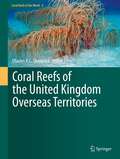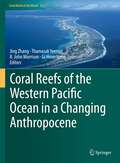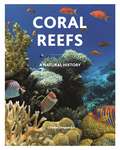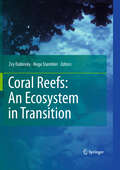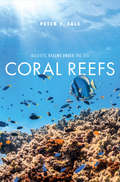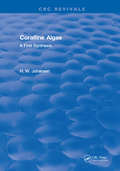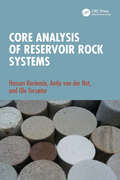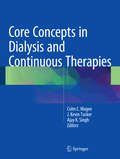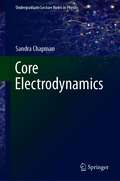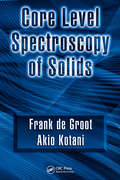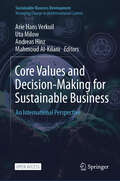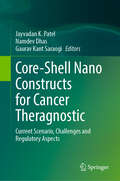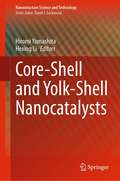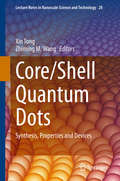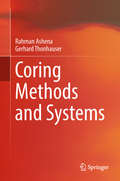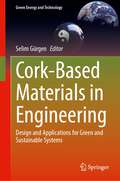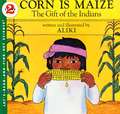- Table View
- List View
Coral Reefs of the United Kingdom Overseas Territories (Coral Reefs of the World)
by Charles R.C. SheppardThe tropical UK Territories have extensive coral reefs. Huge parts of these areas are exceptionally rich, productive and diverse. Their marine biodiversity exceeds that of the UK itself, and several are already, or are planned to be, strictly protected. Some of these areas serve as reference sites for many other countries with damaged reefs and they are oases of tropical marine biodiversity in a fast-degrading world. This book reviews all of the UK reefs, from those scarcely known to those where substantial research has already been performed.
Coral Reefs of the Western Pacific Ocean in a Changing Anthropocene (Coral Reefs of the World #14)
by Jing Zhang Thamasak Yeemin R. John Morrison Gi Hoon HongThe monograph is based on the research and training activities in the Western Pacific Ocean Region within the umbrella of UNESCO/IOC-Sub-Commission for the Western Pacific Region. The results of these activities are compared to cases from other tropical and subtropical regions on this planet to make the knowledge applicable to global aspects of sustainability of coral reef ecosystems. In this monograph, we examine the coral reefs from viewpoint of multidisciplinary approaches, including, environmental impacts, coral biology and system ecology, biogeochemical cycles and processes that drive the material and energy flow through the food web, as well as the proxies in geochemistry that have been used to track the responses of coral reefs to the changing climate and human perturbations. Although this study is focused on the Western Pacific Ocean, the Western Pacific Ocean is so large and diverse that most reef environment types on this planet are located within it. Therefore, knowledge gained in this study is relevant to the application of coastal management in practice as well as in the teaching classes on the interactions between coral reef ecosystems with changing environments.
Coral Reefs: A Natural History
by Charles SheppardAn illustrated look at corals and the reefs they build around the world, and the causes and dire consequences of their rapid disappearanceCorals are among the most varied lifeforms on Earth, ranging from mushroom corals and leather corals to button polyps, sea fans, anemones, and pulse corals. Bridging the gap between plant and animal, these marine invertebrates serve as homes to reef fish and share symbiotic relationships with photosynthesizing algae, which provide corals with their nourishment. This stunningly illustrated book profiles the astonishing diversity of the world's coral groups, describing key aspects of their natural history and explaining why coral reefs are critical to the health of our oceans. Representative examples of corals have been selected to illustrate the broad range of species, and the book's lively and informative commentary covers everything from identification to conservation, making it an essential resource for marine biologists, divers, and anyone who is fascinated by these remarkable sea creatures.Features more than 200 exquisite color photosHighlights key aspects of corals and their natural historyFeatures representative examples from around the worldIncludes photos of rare and unusual species
Coral Reefs: An Ecosystem In Transition
by Zvy Dubinsky Noga StamblerThis book covers in one volume materials scattered in hundreds of research articles, in most cases focusing on specialized aspects of coral biology. In addition to the latest developments in coral evolution and physiology, it presents chapters devoted to novel frontiers in coral reef research. These include the molecular biology of corals and their symbiotic algae, remote sensing of reef systems, ecology of coral disease spread, effects of various scenarios of global climate change, ocean acidification effects of increasing CO2 levels on coral calcification, and damaged coral reef remediation. Beyond extensive coverage of the above aspects, key issues regarding the coral organism and the reef ecosystem such as calcification, reproduction, modeling, algae, reef invertebrates, competition and fish are re-evaluated in the light of new research and emerging insights. In all chapters novel theories as well as challenges to established paradigms are introduced, evaluated and discussed. This volume is indispensible for all those involved in coral reef management and conservation.
Coral Reefs: Majestic Realms under the Sea
by Peter F. SaleAn eye-opening introduction to the complexity, wonder, and vital roles of coral reefs When mass coral bleaching and die†‘offs were first identified in the 1980s, and eventually linked to warming events, the scientific community was sure that such a dramatic and unambiguous signal would serve as a warning sign about the devastating effects of global warming. Instead, most people ignored that warning. Subsequent decades have witnessed yet more degradation. Reefs around the world have lost more than 50 percent of their living coral since the 1970s. In this book, distinguished marine ecologist Peter F. Sale imparts his passion for the unexpected beauty, complexity, and necessity of coral reefs. By placing reefs in the wider context of global climate change, Sale demonstrates how their decline is more than simply a one†‘off environmental tragedy, but rather an existential warning to humanity. He offers a reframing of the enormous challenge humanity faces as a noble venture to steer the planet into safe waters that might even retain some coral reefs.
Coral Whisperers: Scientists on the Brink (Critical Environments: Nature, Science, and Politics #3)
by Irus BravermanIn recent years, a catastrophic global bleaching event devastated many of the world’s precious coral reefs. Working on the front lines of ruin, today’s coral scientists are struggling to save these important coral reef ecosystems from the imminent threats of rapidly warming, acidifying, and polluted oceans. Coral Whisperers captures a critical moment in the history of coral reef science. Gleaning insights from over one hundred interviews with leading scientists and conservation managers, Irus Braverman documents a community caught in an existential crisis and alternating between despair and hope. In this important new book, corals emerge not only as signs and measures of environmental catastrophe, but also as catalysts for action.
Coralline Algae: A First Synthesis
by H.W. JohansenThis book is the first step at pulling together the voluminous but scattered information on coralline algae. Much can be said about these omnipresent plants of the sea, and the purpose here is to provide a coherent frame work of data and discussion.
Corals and Reefs: From the Beginning to an Uncertain Future (Coral Reefs of the World #16)
by Bertrand Martin-Garin Lucien F. MontaggioniThe health status and future of tropical coral reefs, as tourist destinations, are regularly subjected to media coverage. Many documentaries recognize the natural beauty and biological richness of the Australian Great Barrier Reef and French Polynesian lagoons, but point to the equally significant risk that would result from current global warming and human-made hazards. The future of coral reefs is usually a matter of death foretold, real or purely imaginary. In this context, it has become necessary to differentiate between what is falling within reality of scientific facts or fantasy. To this end, the present general review, in the expert translation of Charlotte Fontan aims at: (1) defining the conditions and life requirements of reefbuilding corals; (2) the history of corals along with that of a number of associated, skeletal organisms involved in reef building since the very beginning, i.e. the last 540 million years, including the ups and downs they have experienced; (3) giving special reference to the development patterns of recent and modern reefs; (4) projecting corals and reefs into a still unknown future. Understanding how corals and reefs have originated, how they have been able to face the major biological crises which have punctuated the Earth’s history, how they have survived is a prerequisite to better gain a significant picture of their future.
Cordyceps and Allied Species
by Sunil Kumar Deshmukh Kandikere R. SridharThis book comprehensively covers all aspects of distribution, taxonomy, life cycle, cultivation, application in traditional medicine, their secondary metabolites, and their biological properties, along with various parameters to yield improvement in selected species of Cordyceps. It covers the history, diversity, ecology, taxonomy, phylogeny, genomics, proteomics, metabolomics, various techniques of cultivation, preservation, significance in human health (traditional remedies, modern therapeutics, bioactive potential and curative potential of lifestyle diseases), industrial significance (pigments, nutraceuticals, cosmeceuticals, bioactive macromolecules, fermentation products, metabolic pathways and industrial products), biocontrol potential, market potential and conservation. This book will also highlight the future directions of application-oriented research and the market potential of this economically important genus. The book is an inclusive complication of all classes of metabolites of Cordyceps that are currently being used or are under development, such as antibacterial, antimycotic, biofilm inhibitors, antivirals, antioxidants, anticancer agents, anti-diabetes, anti-inflammatory, anti-angiogenesis, immunosuppressive and immunomodulatory activity. Biotechnological interventions such as epigenetic modifications, co-culture, OSMAC, CRISPER and chemical mutagenesis would also be addressed. The book has been divided into five to six sections addressing different aspects of the bioprospecting of Cordyceps in the discovery and development of drugs, including biotechnological intervention and analytical methods or approaches.
Core Analysis of Reservoir Rock Systems
by Hassan Karimaie Antje van der Net Ole TorsæterCore analysis is an essential source of quantitative data on reservoir properties. These data are used for modeling the distribution and flow of oil and gas reservoirs, CO2 and hydrogen storage, and flow behavior in geothermal reservoirs. While several books cover core analysis for practitioners, this book fills a gap through introducing laboratory equipment and procedures used in core analysis and the theoretical aspects of the parameters. It offers detailed instructions on experimental execution for those with limited or no experience including risk analysis for high safety. Emphasizes the basic characterization of porous materials for multiphase flow, specifically consolidated natural materials Features methods commonly used in the special core analysis within the oil and gas industry, extending to the emerging field of gas storage with occasional references to research-oriented equipment Offers detailed descriptions of laboratory exercises and instructions on data analysis suitable for student work Includes solutions to some exercises to demonstrate the application of measured parameters in reservoir evaluation Provides a unique combination of brief discussions on the basic theory of parameters, explanations of experimental principles, detailed experimental procedures according laboratory standards, and data analysis, with multiple laboratory-related example problems This concise and practical workbook is written for everyone interested in practical measurements of parameters needed for analysis of fluid flow in porous media, specifically students, or for starting staff in the laboratory, preferably with a background in geosciences or fluid mechanics or related topics.
Core Concepts in Dialysis and Continuous Therapies
by Ajay K. Singh Colm C. Magee J. Kevin TuckerThis clinically focused and authoritative guide to managing End Stage Renal Disease (ESRD) patients provides the essentials of hemodialysis, peritoneal dialysis, and continuous therapies. Chapters cover the technical aspects of delivering dialysis therapy, clinical care of patients on dialysis and the evaluation and management of common complications of kidney failure in patients of dialysis - including anemia, bone disease and hypertension. Authored by worldwide leading experts in the field, this book is an invaluable resource for nephrologists and other healthcare professionals involved in dialysis treatment or caring for the ESRD patient.
Core Electrodynamics (Undergraduate Lecture Notes in Physics)
by Sandra ChapmanThis book is intended to engage the students in the elegance of electrodynamics and special relativity, whilst giving them the tools to begin graduate study. Here, from the basis of experiment, the authors first derive the Maxwell equations and special relativity. Introducing the mathematical framework of generalized tensors, the laws of mechanics, Lorentz force and the Maxwell equations are then cast in manifestly covariant form. This provides the basis for graduate study in field theory, high energy astrophysics, general relativity and quantum electrodynamics. As the title suggests, this book is “electrodynamics lite”. The journey through electrodynamics is kept as brief as possible, with minimal diversion into details, so that the elegance of the theory can be appreciated in a holistic way. It is written in an informal style and has few prerequisites; the derivation of the Maxwell equations and their consequences is dealt with in the first chapter. Chapter 2 is devoted to conservation equations in tensor formulation; here, Cartesian tensors are introduced. Special relativity and its consequences for electrodynamics are introduced in Chapter 3 and cast in four-vector form, and here, the authors introduce generalized tensors. Finally, in Chapter 4, Lorentz frame invariant electrodynamics is developed. Supplementary material and examples are provided by the two sets of problems. The first is revision of undergraduate electromagnetism, to expand on the material in the first chapter. The second is more advanced corresponding to the remaining chapters, and its purpose is twofold: to expand on points that are important, but not essential, to derivation of manifestly covariant electrodynamics, and to provide examples of manipulation of cartesian and generalized tensors. As these problems introduce material not covered in the text, they are accompanied by full worked solutions. The philosophy here is to facilitate learning by problem solving, as well as by studying the text. Extensive appendices for vector relations, unit conversion and so forth are given with graduate study in mind.
Core Level Spectroscopy of Solids (Advances in Condensed Matter Science)
by Frank de Groot Akio KotaniCore level spectroscopy has become a powerful tool in the study of electronic states in solids. From fundamental aspects to the most recent developments, Core Level Spectroscopy of Solids presents the theoretical calculations, experimental data, and underlying physics of x-ray photoemission spectroscopy (XPS), x-ray absorption spectroscopy (XAS), x
Core Principles of Special and General Relativity
by James H. LuscombeThis book provides an accessible, yet thorough, introduction to special and general relativity, crafted and class-tested over many years of teaching. Suitable for advanced undergraduate and graduate students, this book provides clear descriptions of how to approach the mathematics and physics involved. It is also contains the latest exciting developments in the field, including dark energy, gravitational waves, and frame dragging. The table of contents has been carefully developed in consultation with a large number of instructors teaching courses worldwide, to ensure its wide applicability to modules on relativity and gravitation. Features: A clear, accessible writing style, presenting a sophisticated approach to the subject, that remains suitable for advanced undergraduate students and above Class-tested over many years To be accompanied by a partner volume on ‘Advanced Topics’ for students to further extend their learning
Core Samples: A Climate Scientist's Experiments in Politics and Motherhood
by Anna Farro HendersonPeople live by their stories—how can we use them to accelerate action on climate change? Climate scientist and policy expert Anna Farro Henderson embarks on a remarkable narrative journey in Core Samples, exploring how science is done, discussed, legislated, and imagined. Through stories both raucous and poignant—of far-flung expeditions, finding artistic inspiration in research, and traversing the systemic barriers women and mothers face in science and politics—she brings readers into the daily rhythms and intimacies of scientific research and political negotiation. Grounded in her experiences as a climate scientist, an environmental policy advisor to Minnesota Senator Al Franken and Governor Mark Dayton, and a constant juggler of the many roles and responsibilities of professional moms, Henderson&’s eclectic, unconventional essays range from observations, confessions, and meditations on lab and fieldwork to a packing list for a trip to the State Capitol and a lactation diary. Readers are invited on voyages as far afield as the Trinity nuclear test site in New Mexico, the Juneau Icefield in Alaska, and a meteor crater in Ghana—and as close to home as a town hall meeting in America&’s corn belt. A love letter to science and a bracing (and sometimes hilarious) portrait of the many obstacles women, mothers, and people digging for truth navigate, Core Samples illuminates the messy, contradictory humanity of our scientific and political institutions. Bringing us behind the closed doors of discovery and debate, Henderson exposes the flaws in research institutions, the halls of government, and the role of science in policy, yet she shows how each crack is also an invitation for camaraderie, creativity, and change.
Core Science class 10 - Meghalaya Board
by Meghalaya Board of School EducationCore Science for Class 10 is based on the recommendations of the NCF 2005 guidelines and the syllabus designed by the MBOSE. The textbook unfolds to the students the three basic branches of Science-Physics, Chemistry and Biology. The book consists of Important terms and definitions, various types of numerical problems with solved examples with experiments related to each topic. The exercises include a variety of questions such as – MCQs, Very short answer questions, Short answer questions-l, Short answer questions-II and Long answer questions.
Core Science class 9 - Meghalaya Board
by Meghalaya Board of School EducationCore Science for Class 9 is based on the recommendations of the NCF 2005 guidelines and the syllabus designed by the MBOSE. The textbook unfolds to the students the three basic branches of Science-Physics, Chemistry and Biology. The book consists of Important terms and definitions, various types of numerical problems with solved examples with experiments related to each topic. The exercises include a variety of questions such as – MCQs, Very short answer questions, Short answer questions-l, Short answer questions-II and Long answer questions.
Core Values and Decision-Making for Sustainable Business: An International Perspective (Sustainable Business Development)
by Mahmoud Al-Kilani Arie Hans Verkuil Uta Milow Andreas HinzThis open access volume discusses the core values and decision-making for sustainable business in general, and includes research findings and country cases on addressing challenges. It emphasizes the importance of adapting products or services to local needs, considering cultural differences and sustainability. Some of the chapters address questions related to improving sustainability in micro, small and medium-sized enterprises (MSMEs), and cover circular economy and responsible consumption. Others look at the normative framework conditions for business development; sustainability in supply chains; the involvement of stakeholders and their influence on market presence; entrepreneurial decision-making for sustainability; and approaches to teaching international and sustainability-oriented entrepreneurship. The volume sheds light on the pivotal role MSMEs play in shaping a sustainable future and is written for researchers, practitioners, and students working on related topics.
Core-Shell Nano Constructs for Cancer Theragnostic: Current Scenario, Challenges and Regulatory Aspects
by Jayvadan K. Patel Namdev Dhas Gaurav Kant SaraogiThis book addresses the critical challenge in cancer treatment, focusing on the precise delivery of therapeutic agents to cancer cells while sparing healthy tissue. It emphasizes the limitations of current cancer therapies and highlights the potential of nanotechnology to revolutionize cancer treatment. It discusses how core-shell nano constructs, with their enhanced stability, biocompatibility, and targeting capabilities, emerge as a promising solution. The book covers the synthesis of novel core-shell nano constructs while elaborating on the chemistry involved in their fabrication. It explores various therapeutic and diagnostic applications of these nano constructs in cancer treatment, considering different materials such as polymers, lipids, and metals and the importance of diagnostics, biosensors, and targeting strategies to achieve site-specific delivery while minimizing toxicity to healthy cells. Additionally, the book addresses regulatory and commercialization aspects,emphasizing the need for comprehensive characterization techniques to assess the effectiveness of core-shell nano constructs. This book is an invaluable resource for students, researchers, and professionals in the field.
Core-Shell and Yolk-Shell Nanocatalysts (Nanostructure Science and Technology)
by Hiromi Yamashita Hexing LiThis book introduces recent progress in preparation and application of core-shell and yolk-shell structures for attractive design of catalyst materials. Core-shell nanostructures with active core particles covered directly with an inert shell can perform as highly active and selective catalysts with long lifetimes. Yolk-shell nanostructures consisting of catalytically active core particles encapsulated by hollow materials are an emerging class of nanomaterials. The enclosed void space is expected to be useful for encapsulation and compartmentation of guest molecules, and the outer shell acts as a physical barrier to protect the guest molecules from the surrounding environment. Furthermore, the tunability and functionality in the core and the shell regions can offer new catalytic properties, rendering them attractive platform materials for the design of heterogeneous catalysts. This book describes the recent development of such unique nanostructures to design effective catalysts which can lead to new chemical processes. It provides an excellent guide for design and application of core-shell and yolk-shell structured catalysts for a wide range of readers working on design of attractive catalysts, photocatalysts, and electrocatalysts for energy, environmental, and green chemical processes.
Core/Shell Quantum Dots: Synthesis, Properties and Devices (Lecture Notes in Nanoscale Science and Technology #28)
by Zhiming M. Wang Xin TongThis book outlines various synthetic approaches, tuneable physical properties, and device applications of core/shell quantum dots (QDs). Core/shell QDs have exhibited enhanced quantum yield (QY), suppressed photobleaching/blinking, and significantly improved photochemical/physical stability as compared to conventional bare QDs. The core-shell structure also promotes the easy tuning of QDs’ band structure, leading to their employment as attractive building blocks in various optoelectronic devices. The main objective of this book is to create a platform for knowledge sharing and dissemination of the latest advances in novel areas of core/shell QDs and relevant devices, and to provide a comprehensive introduction and directions for further research in this growing area of nanomaterials research.
Core: A Science-Backed Approach to Exercising and Understanding Our Central Anatomy
by Owen LewisA holistic, in-depth guide to understanding 'core' strength for therapists, movement professionals, and serious enthusiasts seeking advanced insights into functional training for mental and physical healthHealth magazines, gym-class instructors, and YouTube fitness experts frequently speak of the importance of a strong &“core,&” the muscles at our body&’s center that provide stability and support our movement. We know that improved core function can reduce symptoms of low back pain and pelvic pain, incontinence, and breathing issues. But while the core may be well-known, it is still poorly understood: there is no universally agreed-upon definition of the core or the muscles it comprises. Core adopts a holistic yet practical approach to demystifying the core, considering this crucial muscle group for its physical importance to bodily movement as well as our emotional and spiritual center. Physical therapist Owen Lewis digs into a wide range of metaphors and frameworks used to understand the core—from the Japanese concept of hara, a central storehouse of energy, to the set of specific muscles referenced in fitness studios everywhere. While physical therapy and core-exercise regimens tend to emphasize strength building and stable posture, Lewis argues for an approach that is also flexible, fluid, and adaptable: the same exercises may not be appropriate for every person, and may need to be changed up over time. In some cases, a &“weak&” core may be the result of muscles that are overworked and stressed, and &“good&” posture may create more pain than it prevents. Lewis clearly explains how the core works to manage and transfer the force of movement through the center of the body, building on principles of biotensegrity (how the tension and compression of different muscles creates a balanced structure which distributes stress and strain). The final chapters of the book provide a range of useful, functional training exercises suitable for lay readers but especially helpful as examples for therapists and trainers to use with clients.Lewis emphasizes functional training and underlying principles over a static list of exercises, providing the groundwork for tailored, individual training to improve core function. Supplemented throughout with color photos and a diverse range of models, Core makes it easy to understand the anatomy of this crucial region of the body, as well as key principles for more effective and safe exercises and training regimens.
Coring Methods and Systems
by Gerhard Thonhauser Rahman AshenaThis book is a practical guide to downhole rock sampling and coring concepts, methods, systems, and procedures for practitioners and researchers. Its chapters are based upon years of extensive studies and research about the coring methods and via direct and continuous communication and consultation obtained from various service and operator companies such as Baker Hughes GE, NOV, OMV, and Sandvik. The contributors discuss the state-of-the-art coring methods and systems (mainly used in the petroleum industry), which include: · conventional coring; · wireline continuous coring; · invasion mitigation coring (low invasion, gel coring, sponge coring); · jam-detection, anti-jamming, full closure; · safe-coring and tripping; · oriented-coring; · pressure/in-situ coring; · logging-while-coring; · motor coring; · mini-coring; · coiled Tubing Coring; and · underbalanced coring. The contributors provide practical and applicable understanding of the procedures of these coring methods and systems, as well as the specific core barrel components, working mechanisms, and schematics of the tools and processes used. Because Coring Methods and Systems analyses and compares the core barrels used in both petroleum and mining industries, it enhances the communication and may allow knowledge transfer between the two industries. As core damage is a serious issue during coring and handling jeopardizing correct calibration of exploration data, Coring Methods and Systems has greatly focused on its identification and its mitigation. Therefore, it can be used as an ideal source for geologists, core analysts, and reservoir engineers, to ensure the retrieval of high-quality cores.
Cork-Based Materials in Engineering: Design and Applications for Green and Sustainable Systems (Green Energy and Technology)
by Selim GürgenCork-Based Materials in Engineering Applications provides a set of case studies investigating cork as an eco-friendly and sustainable engineering material. This natural material has had limited applications in engineering until recent years. Recent regulations by European authorities calling for reducing environmentally hazardous and non-recyclable materials have increased interest in cork-based science. Contributors look at cork-based engineering applications, including crashworthiness applications, anti-impact structures, energy-absorbing systems, and vibration-damping devices. Researchers, scientists, students, and practicing engineers working in advanced materials and natural composites will find this unique book an invaluable reference and introduction to the world of cork-based materials and applications.
Corn Is Maize: The Gift Of The Indians
by AlikiPopcorn, corn on the cob, cornbread, tacos, tamales, and tortillas—all of these and many other good things come from one amazing plant. With simple prose and beautiful illustrations, award-winning author-illustrator Aliki tells the story of how Native American farmers thousands of years ago found and nourished a wild grass plant and made corn an important part of their lives. This is a Stage 2 Let's-Read-and-Find-Out, which means the book explores more challenging concepts for children in the primary grades. Let's-Read-And-Find-Out is the winner of the American Association for the Advancement of Science/Subaru Science Books & Films Prize for Outstanding Science Series. Supports the Common Core Learning Standards and Next Generation Science Standards
